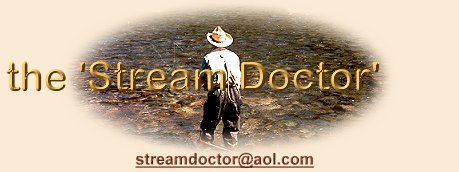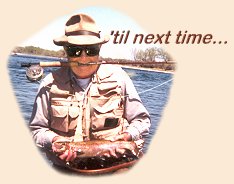
| ||
|
December 15th, 2003
|
|
Q. Do you think watershed analysis will be effective in protecting and/or restoring salmonid habitat in the Pacific Northwest Region?
A.
This is a huge and involved question that
really requires much more space and time
than we have here. Let me try and give you
some of my thoughts on this. Much of this
will be based on the recommendations that former
President Clinton received from the FEMAT plan;
I was a reviewer of the aquatic section for that
document, so know a little about what they have
recommended.
First, of course, watershed analysis alone will
not do the job, but is the obvious first step
in determining where and how we should exert
what resources are available. Merely analyzing
watersheds only defines the status quo; it will
be the implementation that will - or will
not - accomplish any restoration of salmonid
habitat. FEMAT's approach, I believe, is solid
and based on good scientific criteria. Briefly,
as I understood it, it involves identifying
watersheds with the potential for being good
salmonid habitat, beginning restoration in the
headwater reaches, and working downstream to see
that these areas are not further degraded so that
they provide a suitable conduit from the restored
headwater spawning areas to the ocean or large river.
Restoration of riparian corridors, elimination of
back-country roads which result in increased silt
loading, and other similar efforts are included in
the plan. To make a significant impact throughout
the Pacific Northwest will take a large and continuing
dedication of money and effort; this is the part that
scares me because now politics, and not science, gets
stirred into the pot. It will do little good in the
long-term if a significant beginning effort, say
full-funding for 7 or 8 years, is suddenly cut to
lesser funding or less effort for a significant
number of years. I think it will cause the whole
effort to crash, not just part of it. As you probably
know, we're talking about large, integrated ecosystems
extending from the many headwater basins to large
downstream rivers, and these must be treated as wholes,
not pieces, if we are to have significant, long-term
restoration of the habitat for salmonids.
I better stop here; I hope I've given you some
idea of the complexity involved. If you'd like
to pursue this, I'd suggest you get a copy of
the FEMAT document. I might as well throw out
one more personal opinion. Am I optimistic that
this area (I live in Washington State) will get
it's act together and come up with a way to reverse
the downward trend of salmon populations in the
Columbia River drainage? No, I don't see anything
encouraging despite all of the panels, organizations,
teams, etc. that are trying to figure out how to make
this system satisfy everybody, because the bottom
line is habitat and NONE of the plans so far
suggested (except FEMAT) addresses habitat
restoration. You can barge salmon, drawdown
reservoirs, improve passage around dams, or
whatever other things you come up with, it's
still the habitat that counts. There are just
too many large (powerful) self-interest groups
involved who do not have a history of even trying
to cooperate.
~ C. E. (Bert) Cushing, aka Streamdoctor 105 W. Cherokee Dr. Estes Park, CO 80517 Phone: 970-577-1584 Email: streamdoctor@aol.com
|
| If you would like to comment on this or any other article please feel free to post your views on the FAOL Bulletin Board! |
 The 'Stream Doctor' is a retired professional stream ecologist and
author, now living in the West and spending way too much time
fly-fishing. You are invited to submit questions relating to
anything stream related directly to him for use in this Q & A Feature
at
The 'Stream Doctor' is a retired professional stream ecologist and
author, now living in the West and spending way too much time
fly-fishing. You are invited to submit questions relating to
anything stream related directly to him for use in this Q & A Feature
at